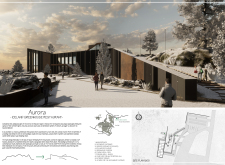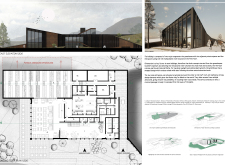5 key facts about this project
The Aurora Greenhouse Restaurant is located near Sandvatn Lake in Reykjahlid, Iceland. The design merges a dining space with a greenhouse, allowing guests to enjoy Icelandic cuisine while immersed in the scenic beauty of the Myvatn region. The approach focuses on blending the building into its natural surroundings, capturing the essence of the landscape in the architectural form.
Architectural Integration
The design showcases a structure that rises from the ground, similar to traditional Icelandic turf houses. This method connects the building with the landscape and encourages a sense of belonging for those who visit. The greenhouse is designed with a stepped layout, which enhances light exposure essential for growing plants while creating a source of fresh ingredients for the kitchen.
Accessibility and Flow
Two main entrances offer paths into the restaurant—one at street level and another that leads to a green roof. This variety in access points improves the movement throughout the space, allowing visitors to engage with the outside environment. The arrangement reflects an understanding of how people navigate, making the building easy to explore and enjoy.
Spatial Organization and Functionality
Inside, the restaurant features high ceilings and large windows that frame views of the beautiful landscape. Glass walls separate the dining area from the greenhouse, inviting diners to experience the growth of their food firsthand. A multipurpose room, adaptable for many activities, has been designed with natural light in mind, thanks to the use of skylights that brighten the space throughout the day.
Materiality and Aesthetic
The materials used include dark wood, glass, and corten steel. Each of these plays a role in supporting the building's goals. Dark wood adds a touch of warmth, while glass facilitates connections between the interior and exterior environments. Corten steel introduces a modern aspect that complements the natural setting, providing a cohesive look that fits well within the rugged Icelandic landscape.
The building’s design features patterns and textures that resemble the local topography, creating an aesthetic that connects both visually and conceptually with its surroundings.






















































